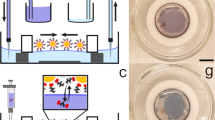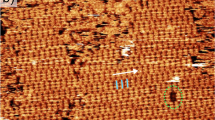Abstract
Highly ordered nanostructured organic/inorganic hybrids offer chemical tunability, novel functionalities and enhanced performance over their individual components. Hybrids of complementary p-type organic and n-type inorganic components have attracted interest in optoelectronics, where high-efficiency devices with minimal cost are desired. We demonstrate here self-assembly of a lamellar hybrid containing periodic and alternating 1-nm-thick sheets of polycrystalline ZnO separated by 2–3 nm layers of conjugated molecules, directly onto an electrode. Initially the electrodeposited inorganic is Zn(OH)2, but π–π interactions among conjugated molecules stabilize synergistically the periodic nanostructure as it converts to ZnO at 150 ∘C. As photoconductors, normalized detectivities (D*) greater than 2×1010 Jones, photocurrent gains of 120 at 1.2 V μm−1 and dynamic ranges greater than 60 dB are observed on selective excitation of the organic. These are among the highest values measured for organic, hybrid and amorphous silicon, making them technologically competitive as low-power, wavelength-tunable, flexible and environmentally benign photoconductors.
This is a preview of subscription content, access via your institution
Access options
Subscribe to this journal
Receive 12 print issues and online access
$259.00 per year
only $21.58 per issue
Buy this article
- Purchase on Springer Link
- Instant access to full article PDF
Prices may be subject to local taxes which are calculated during checkout




Similar content being viewed by others
References
Gomez-Romero, P. & Sanchez, C. Functional Hybrid Materials (Wiley–VCH, 2004).
Mitzi, D. B., Chondroudis, K. & Kagan, C. R. Organic–inorganic electronics. IBM J. Res. Dev. 45, 29–45 (2001).
Petritz, R. L. Theory of photoconductivity in semiconductor films. Phys. Rev. 104, 1508–1516 (1956).
Konstantatos, G. et al. Ultrasensitive solution-cast quantum dot photodetectors. Nature 442, 180–183 (2006).
Konstantatos, G., Clifford, J., Levina, L. & Sargent, E. H. Sensitive solution-processed visible-wavelength photodetectors. Nature Photon. 1, 531–534 (2007).
Mann, S. & Ozin, G. A. Synthesis of inorganic materials with complex form. Nature 382, 313–318 (1996).
Yang, P. D. et al. Hierarchically ordered oxides. Science 282, 2244–2246 (1998).
Stupp, S. I. & Braun, P. V. Molecular manipulation of microstructures: Biomaterials, ceramics, and semiconductors. Science 277, 1242–1248 (1997).
Braun, P. V., Osenar, P. & Stupp, S. I. Semiconducting superlattices templated by molecular assemblies. Nature 380, 325–328 (1996).
Huang, X. Y. & Li, J. From single to multiple atomic layers: A unique approach to the systematic tuning of structures and properties of inorganic–organic hybrid nanostructured semiconductors. J. Am. Chem. Soc. 129, 3157–3162 (2007).
Osenar, P., Braun, P. V. & Stupp, S. I. Lamellar semiconductor–organic nanostructures from self-assembled templates. Adv. Mater. 8, 1022–1025 (1996).
Coakley, K. M. et al. Infiltrating semiconducting polymers into self-assembled mesoporous titania films for photovoltaic applications. Adv. Funct. Mater. 13, 301–306 (2003).
Nguyen, T. Q. et al. Control of energy transfer in oriented conjugated polymer-mesoporous silica composites. Science 288, 652–656 (2000).
Messmore, B. W., Hulvat, J. F., Sone, E. D. & Stupp, S. I. Synthesis, self-assembly, and characterization of supramolecular polymers from electroactive dendron rodcoil molecules. J. Am. Chem. Soc. 126, 14452–14458 (2004).
Reese, C. & Bao, Z. Organic single-crystal field-effect transistors. Mater. Today 10, 20–27 (2007).
Schenning, A. P. H. J. & Meijer, E. W. Supramolecular electronics; nanowires from self-assembled pi-conjugated systems. Chem. Commun. 3245–3258 (2005).
Hulvat, J. F., Sofos, M., Tajima, K. & Stupp, S. I. Self-assembly and luminescence of oligo(p-phenylene vinylene) amphiphiles. J. Am. Chem. Soc. 127, 366–372 (2005).
Sofos, M. et al. Nanoscale structure of self-assembling hybrid materials of inorganic and electronically active organic phases. J. Phys. Chem. C 112, 2881–2887 (2008).
Tajima, K., Li, L.-S. & Stupp, S. I. Nanostructured oligo(p-phenylene vinylene)/silicate hybrid films: One-step fabrication and energy transfer studies. J. Am. Chem. Soc. 128, 5488–5495 (2006).
Choi, K. S., Lichtenegger, H. C., Stucky, G. D. & McFarland, E. W. Electrochemical synthesis of nanostructured ZnO films utilising self-assembly of surfactant molecules at solid–liquid interfaces. J. Am. Chem. Soc. 124, 12402–12403 (2002).
Jing, H. Y. et al. Electrochemical self-assembly of highly oriented ZnO-surfactant hybrid multilayers. J. Phys. Chem. B 109, 2881–2884 (2005).
Usui, H., Sasaki, T. & Koshizaki, N. Ultraviolet emission from layered nanocomposites of Zn(OH)2 and sodium dodecyl sulphate prepared by laser ablation in liquid. Appl. Phys. Lett. 87, 063105 (2005).
Ogata, S., Tagaya, H., Karasu, M. & Kadokawa, J. New preparation method for organic-inorganic layered compounds by organo derivatization reaction of Zn(OH)2 with carboxylic acids. J. Mater. Chem. 10, 321–327 (2000).
Soci, C. et al. ZnO nanowire UV photodetectors with high internal gain. Nano Lett. 7, 1003–1009 (2007).
Law, M. et al. Nanowire dye-sensitized solar cells. Nature Mater. 4, 455–459 (2005).
Mottaghi, M. et al. Low-operating-voltage organic transistors made of bifunctional self-assembled monolayers. Adv. Funct. Mater. 17, 597–604 (2007).
Quist, P. A. C. et al. Photogeneration and decay of charge carriers in hybrid bulk heterojunctions of ZnO nanoparticles and conjugated polymers. J. Phys. Chem. B 110, 10315–10321 (2006).
Beek, W. J. E., Wienk, M. M. & Janssen, R. A. J. Hybrid solar cells from regioregular polythiophene and ZnO nanoparticles. Adv. Funct. Mater. 16, 1112–1116 (2006).
Olson, D. C. et al. Hybrid photovoltaic devices of polymer and ZnO nanofiber composites. Thin Solid Films 496, 26–29 (2006).
Oswald, H. & Asper, R. in Preparation and Crystal Growth of Materials with Layered Structures (ed. Lieth, R. M. A.) 71 (D. Reidel Publishing Company, 1977).
Brinker, C. J., Lu, Y. F., Sellinger, A. & Fan, H. Y. Evaporation-induced self-assembly: Nanostructures made easy. Adv. Mater. 11, 579–585 (1999).
Boeckler, C., Oekermann, T., Feldhoff, A. & Wark, M. Role of the critical micelle concentration in the electrochemical deposition of nanostructured ZnO films under utilization of amphiphilic molecules. Langmuir 22, 9427–9430 (2006).
Yoshida, T. et al. Self-assembly of zinc oxide thin films modified with tetrasulfonated metallophthalocyanines by one-step electrodeposition. Chem. Mater. 11, 2657–2667 (1999).
Blom, F. R., Van de Pol, F. C. M., Bauhuis, A. & Popma, Th. J. A. R. F. Planar magnetron sputtered ZnO films II: Electrical properties. Thin Solid Films 204, 365–376 (1991).
Gijzeman, O. L. J., Langelaar, J. & Van Voorst, J. D. W. Triplet excimer emission from pyrene single crystals. Chem. Phys. Lett. 5, 269–272 (1970).
Loutfy, R. O., Hsiao, C. K., Ong, B. S. & Keoshkerian, B. Electrochemical evaluation of electron acceptor materials. Can. J. Chem. 62, 1877–1885 (1984).
Müllen, K. & Wegner, G. Electronic Materials: The Oligomer Approach (Weinham, 1998).
Broich, B. & Heiland, G. Charge transfer between zinc oxide crystals and dye layers. Surf. Sci. 92, 247–264 (1980).
Munoz, E. et al. Photoconductor gain mechanisms in GaN ultraviolet detectors. Appl. Phys. Lett. 71, 870–872 (1997).
Porter, V. J. et al. Photoconduction in annealed and chemically treated CdSe/ZnS inorganic nanocrystal films. J. Phys. Chem. C 112, 2308–2316 (2008).
Daubler, T. K. et al. Photogeneration and transport of charge carriers in hybrid materials of conjugated polymers and dye-sensitized TiO2 . J. Appl. Phys. 86, 6915–6923 (1999).
Yamamoto, Y. et al. Photoconductive coaxial nanotubes of molecularly connected electron donor and acceptor layers. Science 314, 1761–1764 (2006).
Dong, L., Yue, R. & Liu, L. Fabrication and characterization of integrated uncooled infrared sensor arrays using a-Si thin-film transistors as active elements. J. Microelectromech. 14, 1167–1177 (2005).
Kagan, J., Arora, S. K. & Ustunol, A. 2,2′-5′,2′′-terthiophene-5-carboxylic acid and 2,2′-5′,2′′-terthiophene-5,5′′-dicarboxylic acid. J. Org. Chem. 48, 4076–4078 (1983).
Pacholski, C., Kornowski, A. & Weller, H. Self-assembly of ZnO: From nanodots, to nanorods. Angew. Chem. Int. Ed. 41, 1188–1191 (2002).
Acknowledgements
This work was supported by the US Department of Energy under Award DE-FG02-00ER54810 and the National Science Foundation under award DMR 0605427. Experiments made use of the following facilities at Northwestern University: J. B. Cohen X-ray Diffraction Facility, IMSERC, the EPIC and Keck-II Facilities of the NUANCE Center, the Keck Biophysics Facility and the Institute for BioNanotechnology in Medicine. The NUANCE Center is supported by the NSF-NSEC, NSF-MRSEC, Keck Foundation, the State of Illinois and Northwestern University. We acknowledge facilities support by the Materials Research Center through NSF-MRSEC grant DMR-0520513. XAS measurements were carried out at the DuPont–Northwestern–Dow Collaborative Access Team (DND-CAT) Synchrotron Research Center located at Sector 5 of the Advanced Photon Source. DND-CAT is supported by the E.I. DuPont de Nemours & Co., The Dow Chemical Company, the US National Science Foundation through Grant DMR-9304725 and the State of Illinois through the Department of Commerce and the Board of Higher Education Grant IBHE HECA NWU 96. Use of the Advanced Photon Source was supported by the US Department of Energy, Office of Science, Office of Basic Energy Sciences, under Contract No. W-31-109-Eng-38. We also thank L. Palmer for useful discussions.
Author information
Authors and Affiliations
Corresponding author
Supplementary information
Supplementary Information
Supplementary Information (PDF 5580 kb)
Rights and permissions
About this article
Cite this article
Sofos, M., Goldberger, J., Stone, D. et al. A synergistic assembly of nanoscale lamellar photoconductor hybrids. Nature Mater 8, 68–75 (2009). https://doi.org/10.1038/nmat2336
Received:
Accepted:
Published:
Issue Date:
DOI: https://doi.org/10.1038/nmat2336
This article is cited by
-
Coupling of nanocrystal hexagonal array and two-dimensional metastable substrate boosts H2-production
Nature Communications (2022)
-
Novel Self-assembly Coordination Lipid Polymers that Fold into Toroids with DNA-Delivery Potential
Journal of Inorganic and Organometallic Polymers and Materials (2021)
-
Macromolecular templates for biomineralization-inspired crystallization of oriented layered zinc hydroxides
Polymer Journal (2017)
-
Fabrication and characterization of a nanocomposite hydrogel for combined photocatalytic degradation of a mixture of malachite green and fast green dye
Nanotechnology for Environmental Engineering (2017)
-
Macromolecular templates for the development of organic/inorganic hybrid materials
Polymer Journal (2015)



